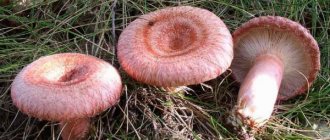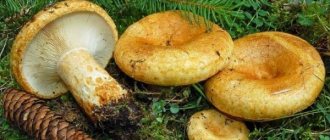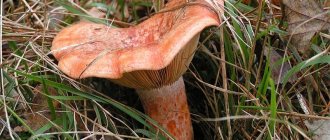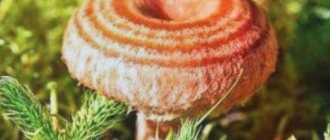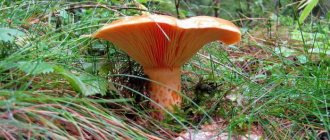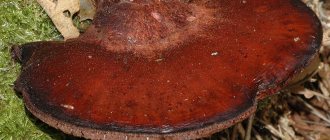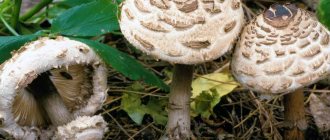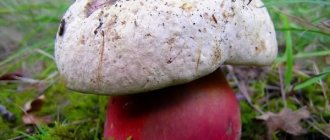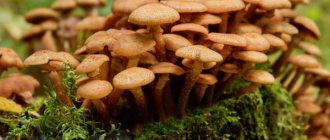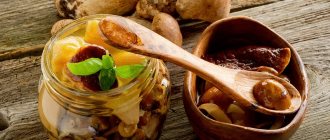Do you know that even at a time when there are, at first glance, no mushrooms in the forest, you shouldn’t despair? Take a closer look, there may be some voles growing not far from you! This beautiful, remarkable fruit not only attracts attention, but is also very tasty in the form of pickles, preparations, and fried dishes. In addition, the little ones grow in groups; if you find one, there is a high probability of collecting at least half of the basket! Find out everything about this type of mushroom, check out the detailed cooking recipes.
What they look like
Volnushki belong to the genus of laticifers, the Russula family.
These are lamellar, conditionally edible mushrooms, which must be thoroughly processed (soaked, boiled) before cooking. There are several types of wavefish: white (Lactárius pubéscens), pink (Lactárius torminósus), marsh or black milky (Lactárius viétus). Very often, mushroom pickers call the real milk mushroom a volushka, but in fact it is an ordinary pink volushka.
Description of pink wave
This fungus can be called: volnyanka, volnovukha, volzhanka, volvenka, volvyanitsa, volminka, rubella, krasulya, decoction.
The Latin name is Lactarius torminosus. Interesting to know! Volnushki got their name due to the special coloring of the cap, which resembles waves diverging from the center to the edges.
The cap has a size from 4 to 12 centimeters; in young fruiting bodies it is convex, and flattens as it grows. In the center you can see the umbilical cavity (funnel), the edges of the cap are lowered.
The skin is slightly slimy and has coarse villi arranged in uneven circles. The color is gray-pink or pale pink, darkens when pressed. If the fruit body grows in dry places, then the color of the cap turns pale and fades.
When cut, the pulp has a dense structure, it is strong and snow-white. The taste is spicy. The milky juice is also white, sharp, and is released very abundantly when the body is broken.
The hymenophore (bottom layer of the cap) is a whitish plate with a pink tint, which turns yellow over time. They are not wide, often located, descending along the leg. Between them there are intermediate plates. The spore powder is creamy white or white.
The leg is cylindrical, strong, hard, tapering towards the base. In young specimens this part is solid, but becomes hollow with age. The color is pale pink, the surface is covered with fluff and small depressions.
Jacob Christian Schaeffer was the first to describe the pink trumpet in 1774, and in 1797 he assigned the binomial name to this species - Lactarius torminosus.
Where does it grow and when can it be found?
Habitat: mixed with birch and birch forests. Volnyanka forms mycorrhiza with this tree. It grows in groups, mainly in the northern part of the forest zone.
Rubella is harvested in the last ten days of June, and this process continues until October. Peak yields occur from late July to late August and early September.
Volnushka white
This species is also called whitefish in Siberia.
Latin name: Lactarius pubescens. The diameter of the mushroom cap ranges from 4 to 8 cm, it is white, very similar in structure and characteristics to the pink cap.
The hymenophore is an adherent, dense, narrow plate. Spore powder is milky or creamy.
The pulp when cut is dense, brittle, white in color and has a faint odor.
The leg is cylindrical, the same color as the cap, smooth or slightly pubescent.
This mushroom was first described by Elias Magnus Fries, a Swedish botanist and mycologist, in 1838, giving the species the binomial name Lactarius pubescens.
It is important to know! With age, this fruiting body may slightly change color from white to yellowish, and the cap becomes smoother.
Where does it grow?
Just like volyanka, whiteweed forms mycorrhiza with birch, prefers the edges of birch groves and rare spruce-birch young growths. Occurs frequently in large groups. Fruiting season: beginning of August - end of September.
Types of waves
Volnushki belong to the second category of edible mushrooms. This is a good indicator, considering that there are only four such categories.
Volnushka has several subspecies:
- pink wave (Volzhanka);
- white wave (white);
- yellow wave (volnukha);
- swamp wave (faded milkweed);
- gray volnushka (gray milky or serushka).
These subspecies differ only in external characteristics, but in taste they are almost indistinguishable.
The most famous of the waves are pink and white.
Volnushka pink
Pink trumpet (Lactarius torminosus)
This mushroom stands out from the group of its fellows due to its large size and attractive appearance. Young mushrooms “wear” a beautiful convex pink cap, which gradually flattens, forming a small depression in the center. The edges of the cap are rolled up at the bottom and have a slight edge. When it rains, it secretes mucus and becomes slippery. The mushroom has white flesh, which sometimes has a pinkish tint. Since volnushka is a fairly dense and strong mushroom, even during long-term transportation it does not break or crumble, and remains unharmed.
The cap of the pink wave reaches a fairly large size, approximately 15 cm in diameter, and has a beautiful pattern of rings reminiscent of waves. Since the mushroom grows very quickly, it reaches this size in 3–4 days.
White wave
White trumpet (Lactarius pubescens)
Another name for the white wave is fluffy white. It is slightly smaller in size than the pink one with a cap diameter of 4 to 10 cm. Unlike its pink “sister”, it has a white cap with a cream tint without any funnel-shaped patterns. In the central recess the color changes to darker. A white milky juice that does not change color is released from the cut. The strong stem of young mushrooms becomes hollow as the mushroom grows. The stem and cap are similar in color. Old mushrooms become brittle, the plates turn yellow, the smooth edges become torn, and the mushroom becomes similar to a milk mushroom.
Features, beneficial properties and possible harm
There is no definitive data on the edibility of the mushroom.
Foreign sources consider the trumpets as a poisonous species prohibited for consumption.
In Russia, on the contrary, Volyanka is treated very favorably; it can be fried, pickled, stored for the winter, frozen, canned, boiled, etc. All these processes can be done only after the bitter milky juice has been removed - after soaking and prolonged cooking
The composition of these fruiting bodies deserves special attention. It contains several acids: lactic, acetic and oleic, as well as chitin, which is known for its ability to bind lipids and prevent the absorption of fats.
Volnushki are rich in vitamins: A, B1, B2, E, C, PP, etc. These mushrooms contain eighteen types of amino acids, as well as biologically active substances, glutamic and aspartic acids.
It is important to know! Chitin can not only be beneficial, but also harm the body, since this substance is difficult to digest by the gastrointestinal tract. That is why it is not recommended to consume mushrooms for children under 12 years of age, pregnant and lactating women, allergy sufferers and people with health problems.
Useful properties of waves:
- The calorie content of mushrooms is only 22 kcal per 100 g, but these fruiting bodies are very nutritious and can quickly satisfy your hunger.
- Helps stabilize glucose levels and cleanse blood vessels.
- Biologically active substances have a beneficial effect on the condition of the skin and strengthen the immune system.
- They help improve brain function, correct vision problems, have a good effect on blood vessels, joints, and the nervous system, and can prevent the development of hypertension and even oncology.
For whom are waves harmful? Contraindications to eating mushrooms
People with cholecystitis and a removed gallbladder, pancreatitis, or low acidity of gastric juice limit or completely remove the mushroom from the diet. After cooking, the fruiting bodies lose their bitterness. But the milky juice of the volnushka does not change the composition and has an irritating effect on the mucous membranes.
Children under 3 years old do not have enzymes in their bodies that would allow them to digest mushrooms, and not just mushrooms. In general, this is a safe and healthy mushroom if you follow the basic rules of gastronomic hygiene.
How to process trumpet mushrooms before cooking
At the site of damage, the mushrooms secrete a caustic milk. It spoils the taste of the dish, causes gastrointestinal upset or poisons. No heat treatment can neutralize the poisonous milky sap. Therefore, you need to approach mushroom harvesting carefully and add only edible or conditionally edible mushrooms to the pan.
Neutralize the bitter taste by soaking or boiling.
Soaking
The caps are collected, the caps are cleared of adhering debris, and they are filled with clean water. They leave it. During the process, the water is changed every 5 hours, the old water is drained. Then rinse thoroughly with running water. Again immersed in cold water. For every liter of water add 10 grams of salt or 2 grams of citric acid. Soak the crop for 2 days or more. At the final stage, the mushrooms are cleaned with a brush and washed again under running water.
How to cook volushki so that they don’t taste bitter?
The best rubellas from the point of view of culinary use are young specimens. They have a more interesting taste, and the milky juice is not so bitter.
Fresh mushrooms should be placed in the refrigerator, wrapped in a paper bag. It is advisable that each mushroom be separately wrapped in a damp cloth or paper towel.
Since the pulp of these mushrooms contains a rather bitter and caustic milky juice, before use they must be soaked for 24 hours, changing the water 3-4 times. Then you need to boil for 15–20 minutes, drain the water and, adding another, cook again.
Volnushki are mainly used for salting and pickling.
Despite the fact that at the same time they lose their beautiful color and acquire another one - gray-gray, pickled and salted trumpets are a very tasty dish and a real table decoration.
Where do wolves grow?
Yellow trumpet (Lactarius scrobiculatus)
Volnushka is a mushroom that is widespread everywhere; it grows in all forests where there are birch trees. There is especially a lot of it in pure birch forests, but it can also be found in mixed forests, the main thing is that birch is present. The birch tree has an inextricable connection; they form mycorrhiza, the so-called fungal root. The birch tree needs this mushroom just as much as the birch tree roots. This is how they support each other throughout their existence.
Gray trumpet or gray milkweed (Lactarius flexuosus)
Volnushki begin to appear in the forest in mid-summer, and if it is warm and rainy, then in June. These mushrooms are frost-resistant, so they can be harvested right up until October. They do not grow singly, but in whole families; you can often find yourself in an orange-pink clearing in the forest, completely covered with the pink caps of moths, which prefer open places, but sometimes they can be found in dense bushes and windfalls. White trumpets, on the contrary, love space and light, so it is best to look for them at the edge of the forest, without going deep into the thicket.
How to cold salt salt in jars for the winter? Simple recipe
Before salting the volushki using this method, be sure to prepare the container.
Glass jars need to be washed well with soda and sterilized: in the microwave, oven, over a special pan. This will not only preserve the preparations for a long time, but will also prevent botulism.
Ingredients:
- Volyanka – 5 kg;
- salt – 250 g;
- cloves – 10 buds;
- vinegar – 300 ml;
- water – 2.5 l;
- garlic – 3 cloves.
Cooking plan:
- Pre-prepared, soaked mushrooms should be placed in a container and cooked for 25 minutes, until they settle to the bottom.
- Rinse the fruiting bodies, add 2.5 liters of water, let the mixture boil, add salt. Cook for 10 minutes.
- The garlic needs to be peeled and sliced.
- Place all the spices and seasonings in a container with mushrooms, pour in vinegar, and cook for 15 minutes.
- Distribute the volnushki into jars, fill with boiling brine, and seal.
- Store in a cool place.
Features of mushrooms
Volnushki are interesting mushrooms that can behave differently under different treatments. Because of this, it is often questioned whether they are edible.
The following characteristic features of these mushrooms are distinguished:
- When cut and in contact with oxygen, the volnushki turn green. There is nothing wrong with this, it’s just the specifics of this mushroom.
- Sometimes mushrooms turn blue when pickled and when cut. However, this has nothing to do with waves. This happens when a mushroom picker confuses saffron milk caps with saffron milk caps, since saffron milk caps tend to change color in such situations.
- Very often, in brine and after any heat treatment, the waves darken. This shouldn't scare you either, as it's normal and doesn't affect their taste at all.
- Quite often, volnushki can turn pink during soaking. This is another feature of the mushroom that should not be scary.
- The longer the waves lie in the liquid, the more intensely they lose color.
- But the mushrooms can become bitter only in one case: when they were not soaked enough and not boiled, which is why the juice did not come out completely, remaining in the pulp of the mushrooms.
How to marinate hot?
Find out how to properly prepare pickled rubella for the winter. A fragrant mushroom appetizer with garlic and onions will not leave anyone indifferent!
Ingredients:
- volukhi – 2 kg;
- water – 700 ml;
- onion – 500 g;
- garlic – 7 cloves;
- salt – 80 g;
- sugar – 1 tbsp. l.;
- vinegar – 100 ml;
- bay leaf, allspice – 4–5 pcs.
Cooking method:
- Soak the mushrooms for 2 days. Boil in salted water for 25–30 minutes.
- Rinse, drain in a colander, and let the liquid drain.
- Peel the onion and cut it into thin half rings. Chop the garlic into slices.
- Pour water into a saucepan, add sugar, salt, spices, and place the sourdough. Cook everything for 10–15 minutes.
- Add onion, garlic, vinegar, cook for another 15 minutes.
- Place the volokhi into clean jars and pour boiling marinade over them. Cork.
- The preservation must cool at room temperature, only after that it can be sent to the cellar or basement.
Volnushka poisoning. Symptoms and signs
Often people:
- violate the rules for processing freshly picked mushrooms;
- ingredients are not dosed correctly;
- do not follow cooking recipes;
- they forget that they have problems with the stomach and other internal organs.
In all these cases, eaters receive intestinal disorders and mild or moderate poisoning.
Symptoms and signs of mild mushroom poisoning appear within 1-6 hours. The person feels nauseous, dizzy, and has a stomach ache. The condition lasts 1-2 days, then remission gradually occurs.
To alleviate the condition, they give sorbents, give an enema, and induce vomiting. This is first aid. Be sure to go to the infectious diseases department, where they will take tests and prescribe treatment.
How to prepare caviar from tremors with tomatoes?
If you have brought a large harvest of these wonderful mushrooms from the forest, prepare aromatic, sweet and sour caviar from them. It perfectly complements main dishes, and can also serve as an independent snack.
Ingredients:
- rubella – 1 kg;
- tomatoes – 1 kg;
- salt - to taste;
- vegetable oil – 500 ml;
- onion – 1 pc.
Cooking method:
- Pre-soaked fruit bodies should be boiled in salted water for 25 minutes.
- Drain the water and repeat the process again.
- Peel the onion and cut into medium cubes. Do the same with tomatoes. Pass the vegetables through a meat grinder.
- Combine mushrooms and vegetable mass in one deep container, pour in vegetable oil, add salt.
- Place the pan on low heat and simmer for half an hour.
- Place the hot caviar into clean jars and cover with a lid.
- Sterilize each liter container in boiling water for 15–20 minutes. This is necessary to ensure that the preservation is well preserved.
It is important to know! You can eat salted trumpets only 50 days after salting!
Methods for growing trumpets at home
You can grow volnushki yourself, indoors or on your own summer cottage.
Volnushka pink
Methods for obtaining mycelium
Mycelium is used to grow this type of mushroom. You can get it in the following ways:
- collect overgrown mushrooms in the forest, chop them finely, dry them in a shaded area for 24 hours;
- collect overripe mushrooms in the forest, cut them, add cold water, leave for a day, stirring the contents from time to time with a wooden stick.
Rules for planting mycelium on the site
Having received the material for planting, you should prepare a plot of land. The soil needs to be dug up and organic fertilizers added. Place the prepared planting material into the deep grooves.
Sprinkle the material with sawdust on top, and then with a thick layer of leaves, straw or hay. There is no need to water the plantings.
Volnushki should be planted in a place that is well lit by sunlight. Humidity levels should be low.
In the first year after planting, it is not recommended to harvest the crop: it is better to wait until it is fully ripened, which will allow for additional crops. From the second year you can pick mushrooms.
Unlike oyster mushrooms or champignons, you can get a harvest from planting oyster mushrooms only once a year, although you can cut them in one area several times.
Other cooking recipes
Volnushki are such versatile mushrooms that you can make any dish from them: soup, roast, used for filling pies and pies, grilled, salted, used for freezing for the winter.
Volnushki in sour cream
A very simple and quick way to quickly process fruiting bodies at home.
An excellent addition to any side dish.
Ingredients:
- krasuli – 1 kg;
- onion - 1 head;
- garlic – 3 cloves;
- sour cream - 1 tbsp.;
- flour – 1 tbsp;
- a little vegetable oil;
- salt, spices.
Cooking method step by step:
- Pre-soaked mushrooms need to be prepared: cut large mushrooms into pieces, leave small ones as is.
- Boil the fruiting bodies in salted water 2 times for 20 minutes.
- Finely chop the onion and garlic, fry in oil until soft.
- Place the boiled and dried trumpet mushrooms in a frying pan with vegetables, fry everything together for 5-7 minutes.
- Add sour cream, spices, salt and simmer until tender (10–15 minutes).
- Serve with potatoes, sprinkled with herbs.
Differences between a real mushroom and a false one
Differences between edible real trumpets and inedible false ones:
- mandatory presence of an edge along the edge of the mushroom;
- pronounced pink color of the cap with rings on the surface;
- curved edge shape;
- The juice is white when broken and has a characteristic pungent odor.
You should be careful when collecting these mushrooms, carefully review them, discarding unsuitable and questionable specimens, but at the same time similar to edible specimens. Also, one should not neglect the rules of proper processing before use.
False doubles
Volnukhas can often be confused with other species, so it is very important to thoroughly know how to distinguish similar mushrooms. Among them there are edible and poisonous representatives of the forest kingdom. In the table and in the photo you can see all the differences between these varieties:
| Name | Edible | Name | Poisonous, inedible |
| Common milkweed | The young mushroom has a dove-gray, convex cap; old - brown or purple, later it becomes ocher or yellow and becomes flatter. The edges are slightly wavy, turned inward; the stem has a cylindrical shape of a grayish or yellowish color. The milky juice turns greenish when cut. | Milky spiny | The color of the cap varies from pink to red-brown, and small red scales may be present. The pulp is ocher or white, sometimes closer to green, there is no smell, the taste is very pungent. |
| Faded milky | The cap varies from lilac to white or gray with a slight convexity and a depressed center, darker than the edges. The leg is smooth and curved, much lighter than the cap. | Milky sticky | Gray-green cap with dark spots. The center is darker than the edges. The leg is sticky, lighter than the cap. The pulp is white, odorless, and has a hot, peppery taste. The milky juice is sticky and turns green when broken. |
| Brownish milkweed | The cap is velvety, brown or dark chocolate; as the fruiting body grows, its shape changes from convex to depressed. The flesh turns pink when broken and has a fruity aroma. | Milky liver | An absolutely smooth funnel-shaped cap, brown with the addition of olive. The pulp is brittle, light brown in color, extremely caustic. The milky juice turns yellow |
| Milky brown | A dark chestnut or brown, almost black cap with a convex tubercle, which then disappears and a depression appears. There is a edge on the wavy edges. The stem is cylindrical and almost always has the same color as the cap. The milky juice is not thick and not caustic. | ||
| Milky hygrophoroid | The dry cap is brownish in color, sometimes there is a brown or reddish tint, with a slight convexity, which then disappears, becoming depressed over time. Very fragile appearance with white flesh. | ||
| Milky-hot milky | The cap is moist, mucous, rounded in the center with a tubercle, becoming concave with age. The pulp is light gray in color, dense with a pleasant aroma, and has a burning taste. |
Are there false flies and how to distinguish them from edible ones?
Do tremors have false inedible representatives and how to distinguish them? This question is often of interest to novice lovers of “silent hunting”.
White and pink trumpets do not have poisonous or inedible counterparts. Sometimes they are confused with pale milkweeds, but this species also belongs to the conditionally edible species. Often it is the milkies that are called false waves. They have pink caps, but they are smaller and there is no edge on the edges.
Milkweeds also grow on birch roots in damp places. The main difference between these species is the absence of the edge on the cap of the milkweed.
Important! These mushrooms, like tremors, after soaking or boiling, are safe to eat salted or pickled.
YOU MAY BE INTERESTED in: Camelina mushrooms: photos and descriptions of edible and false species, difference from saffron mushrooms
Distribution and habitat
Volnushki have populated the vast expanses of Russia in large numbers, preferring birch groves and mixed forests. They do not grow alone, only in family groups, and choosing the northern direction. They love places open to the sun, although they are also found in darkened thickets of bushes.
Usually, the wood is found under old birch trees. This is explained by the fact that it shares mycorrhiza with the tree - a common fungal root. Birch also needs such a neighborhood, so they live nearby, providing kind help to each other.
